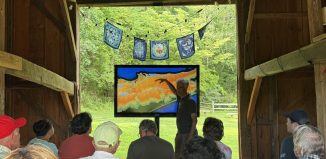Book Review: ‘DDT Wars’ by Charles F. Wurster
Reviewed by Melissa Arnold

In 1972, the pesticide DDT was banned across the United States following proven harmful effects on wildlife. The positive impact of the ban cannot be understated. According to a recent study by the Connecticut Audubon Society, the population of ospreys is 31 times greater than it was in 1970. The bald eagle population is 25 times greater nationwide.
But before the ban, former Stony Brook University professor Charles Wurster found himself at the forefront of the battle to stop DDT. His book, “DDT Wars: Rescuing Our National Bird, Preventing Cancer, and Creating the Environmental Defense Fund” (Oxford University Press, 2015), recounts the story from Wurster’s perspective in vivid detail, from his childhood to the establishment of the Environmental Defense Fund and beyond.
I recently had the opportunity to interview the 86-year-old professor emeritus, now living in Maryland, by phone.
Were you always an animal lover?
Yes, I think so. My parents weren’t much into wildlife, but they always showed excitement when they saw animals, so those were little encouragements for me. But from age 11 to 20, I spent every summer at a camp in the mountains of Pennsylvania — that put me in a natural environment and I learned bits and pieces about wildlife, especially birds, turtles and snakes. Later on, a high school teacher took a car full of students to Florida in the summer to learn about birds, which sparked my interest in a big way.
Do you remember when DDT was first used?
I was teaching at Dartmouth in 1962 and went to a cocktail party for a birding friend, who said they were spraying Dutch elm trees with DDT [to eradicate Dutch elm disease]. She told me it was killing birds and she had dead birds in her yard. I signed a petition at the party to stop the use of DDT in the town, but the town fathers ignored it, saying they were being very careful.
What made you realize that DDT was harmful?
When the town refused to stop using DDT, some of us decided to perform a study to see what happened. We compared bird populations before and after they sprayed the trees, and at first there were no dead birds. But within a few weeks, we began to find birds that were convulsing and then dying. At the time we had no knowledge of the [scientific] literature that was already published about DDT. Gradually, we began to catch up with it, and eventually we published a study in Science Magazine, which gave credibility to our work.
Did you ever see yourself getting involved with the effort to ban DDT?
I never dreamed I would get involved with such a thing. It was very incremental. I wanted to stop the use of DDT in Hanover [Massachusetts], and the effort succeeded by the next year. Eventually, I moved to Long Island, where I got involved in efforts there to stop the use of DDT. [In New York], they were focusing on its effects on ospreys, which were not reproducing properly and eating their own broken eggs. A group of us filed a lawsuit and were able to get an injunction in two weeks. That news was electrifying. It got us to start thinking bigger. In the fall of 1967, we incorporated the Environmental Defense Fund (EDF), with the goal of bringing science into the courtroom. We hadn’t the remotest idea of what it would be at that time — we were just a group of 10 people with an idea.
What was it like to fight against the use of DDT? Did people listen or did they disregard you?
At that time, much of the general public was becoming environmentally aware and involved, so they were generally favorable to us. Wherever we went, there were droves of birders and environmentalists rushing out to help, which was an excellent support. But the (pesticide) industry also began pushing back, even though they didn’t have the science to support their case. Several federal agencies tried to throw us out of court, but they failed.
What were you feeling?
It was scary in a way, because we knew we could get shut down and the industry was saying nasty things about us. But we believed it was the right thing to do. It’s like watching a football game — you’re cheering for the team, and you’re likely to lose, but you stay in the stands anyway because anything could happen. The EDF got to a point where we knew we were the ones that could [ban DDT], and we really wanted to win this thing, so we pushed forward.
Did your life change in any way afterward?
After the ban of DDT, I really started to focus on the development of EDF and various other environmental issues. I still sit on the board of trustees today.
What made you want to write a book about this issue decades later?
Within the past ten years, I started to realize that our story was being forgotten. Most people didn’t know how DDT was banned, and there was a lot of false information given in the media saying that Congress had banned it. That was so annoying to me — we purposely avoided Congress! And that same junk science presented about DDT was being used to influence the climate change issue. I started to get after several people I knew who I thought could write a book, but in the end, almost everyone who was actually there for the ban had died. I thought, “Gosh, I’d better do this.” But it was never a plan of mine.
What is the greatest lesson you learned from your experience?
I think it’s that one person can begin to make a difference, but you can’t always be a one-man band. The critical work and studies on DDT were done by so many different people, and we weren’t all present at every hearing. It was important for us to work together.
Why do you think your book is relevant today?
One reason is because it’s just interesting — I intended it to read like a novel, even though it’s completely true. But it also gives a great case history for how a small group of people can make a difference. So much (in society) has changed, but that idea is still true. So many people have this hopeless feeling that they don’t matter and there’s nothing they can do, but this book sends the opposite message — if there’s something you feel strongly about, get out there and do something about it!
What can we do to aid in wildlife conservation efforts on Long Island?
Find a group of people that share a common purpose that matters to you. Working as part of a team, you can escalate those issues and help to create big changes.
“DDT Wars” is available online at www.barnesandnoble.com and www.Amazon.com.







